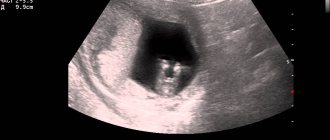Features of the method
Doppler testing during pregnancy is one of the types of functional ultrasound diagnostics that examines the nature and intensity of uteroplacental and fetal blood flow.
The essence of the sensor’s operation is to detect a change in the frequency of the ultrasonic wave, which occurs against the background of uneven blood flow in the vessels. The data is reflected in the form of curved lines characterizing the intensity and speed of blood flow. Doppler examines the artery, vessels, umbilical cord veins, uterine arteries, aorta and cerebral arteries of the fetus.
How to understand if there is hypoxia
It is based on the results of a Doppler ultrasound that the gynecologist can see whether oxygen starvation of the fetus is occurring, whether the child is receiving all the necessary substances and what to prepare for during childbirth.
What abnormalities can fetal Doppler ultrasound detect?
- Exceeding the values of IR and SDO in the uterine arteries is a sign of oxygen starvation of the fetus. This can subsequently lead to delayed growth and development.
- Feto-placental insufficiency will be indicated by an excess of Doppler values for the umbilical cord artery. This is a vascular pathology that leads to fetal suffering. This is also a sign of gestosis.
- Hypoxia of one of the fetuses during multiple pregnancy (transfusion syndrome) is indicated by the difference between the IR and SDO indicators in the umbilical cords.
- The child may feel unwell if labor is delayed, diabetes mellitus in the pregnant woman, or Rh conflict. This is indicated by an increase in SDO and IR in the aorta.
- But a decrease in these same values in the carotid and cerebral arteries is observed in extremely severe conditions of the fetus, since in this case only the main organs that support life are supplied with blood and oxygen. In such cases, it is recommended to immediately carry out artificial labor.
Dopplerography of the fetus is one of the important diagnostic measures carried out by a pregnant woman, revealing disorders in the blood vessels and the utero-placental-fetal system. Thanks to the results of the blood circulation analysis, the doctor makes a decision on the tactics of managing pregnancy and childbirth in the future.
Why is Doppler ultrasound needed?
During pregnancy, Doppler testing is performed on almost every woman. There is a precisely defined period when it makes sense to do it. Normal blood flow from the mother through the placenta to the fetus is the key to the full development and birth of a healthy child, and also ensures the well-being of the pregnant woman.
Doppler measurements can promptly detect disruptions and changes in blood circulation , as well as determine the exact area in which blood supply is difficult.
Doppler testing is necessary for:
- maintaining pregnancy;
- preventing premature birth;
- preventing fetal hypoxia;
- normal intrauterine development of the child;
- maintaining the health of the mother and preventing gestosis.
Doppler testing during pregnancy helps to identify disturbances in the blood supply to the fetus.
Disruptions in blood flow can occur at the very beginning of the gestational period, when the fertilized egg attaches to the wall of the uterus. If implantation is incorrect, the development of blood vessels is delayed, which causes a failure of the uteroplacental circulation. If this happens, there is a high probability of miscarriage early in pregnancy.
Also, pregnancy can continue, but due to initially incorrectly developing blood vessels, the child may experience a deficiency of nutrients and oxygen.
Disturbed formation of the placental and uterine arteries poses a threat to the health and life of the mother and her unborn child. A woman does not adapt properly to pregnancy, and there is a risk of developing a very serious condition - preeclampsia.
Dates
Doppler testing during pregnancy is a diagnosis that is carried out at precisely defined times. The only exception may be the need for additional diagnostics.
Doppler testing is recommended at 18-20 and 32-34 weeks of pregnancy
Doppler measurements are done at the following times: 18-21 weeks and 32-34 weeks. There is no point in doing Doppler before the 18th week of pregnancy, since the placental vessels have not yet had time to fully form.
In many women (about 30% of cases), the uterine arteries complete their development only at 22 or even 25 weeks. Therefore, if a one-time disruption of the blood supply is detected, the procedure should be repeated. Often, circulation naturally returns to normal between 22 and 25 weeks and no medication is required.
If there are significant changes in blood flow and pathologies are detected, the pregnant woman is prescribed full treatment, and special medical control is established over her. In this case, Doppler measurements are performed every month or half a month.
Doppler ultrasound examines the intensity of blood flow, determines the position of the child, the condition of his arteries and heart, the presence or absence of oxygen deficiency, and the entanglement of the umbilical cord.
When and why to do Doppler ultrasound during pregnancy
Doppler sonography is prescribed to identify intrauterine oxygen deficiency, which causes disturbances in the development of the fetus. Thanks to it, it is possible to detect heart defects in a baby at an early stage.
Doppler examination of the fetus is prescribed to all mothers at 32 weeks.
If there are complications, the procedure may be scheduled for 22 weeks.
The examination is carried out in the same way as an ultrasound.
As in the case of an ultrasound examination, the woman is in a lying position, and the doctor moves a special sensor over her abdomen.
No special preparation is required before the procedure. There is no need to drink a lot of fluids or follow a special diet.
All this does not affect the result. The only thing that can affect the indicators is smoking. Therefore, you should abstain a couple of hours before the examination.
The duration of the procedure is about half an hour. The woman does not experience any unpleasant sensations. Results can be obtained immediately after the study.
During the examination, a picture is displayed on the monitor where shades of red represent blood flow directed towards the sensor, and blue flowers - from it. The brighter the color, the faster the blood flow.
Indications for Doppler testing
Doppler testing during pregnancy is a recommended examination for every pregnant woman. Typically, it is carried out 2 times during pregnancy. Additional studies are only prescribed by a doctor.
Indications for the study:
- age less than 21 years or more than 34 years;
- unsatisfactory indicators of the aquatic environment;
- multiple pregnancy;
- maternal urinary tract diseases;
- the umbilical cord is located near the child’s neck or wraps around it;
- in case of a previous pathological pregnancy and childbirth;
- negative Rh factor of the pregnant woman;
- presence of Rh antibodies in the blood;
- fetal growth retardation syndrome;
- accelerated aging of the placenta;
- poor CTG results;
- diabetes;
- hypertension;
- unsatisfactory results of cardiotocography;
- suspicions of deviations in the development of the child’s internal organs;
- trauma during the gestational period;
- delayed onset of labor;
- gestosis.
What is ultrasound
A woman undergoes a huge number of different studies while carrying a child.
They are carried out in order to identify the child’s diseases at the initial stage, as well as complications that may lead to problematic childbirth. The list of such examinations includes Doppler ultrasound. Considering what an ultrasound scan is during pregnancy, it can be noted that this is an ultrasound examination that helps evaluate blood circulation in the child’s organs. It helps to determine what condition the fetus is in.
This procedure also helps to see the activity of the placenta and blood circulation in the arteries of the uterus. It is very important to conduct Doppler ultrasound for pregnant women with blood clotting problems.
Since Dopplerography during pregnancy is carried out in conjunction with ultrasound, many ultrasound machines have the additional function of Dopplerography.
In simple terms, what is Dopplerography is the only way today to examine the blood vessels of a pregnant woman and her baby.
How is this procedure carried out?
Doppler testing during pregnancy is a procedure that does not require special preparation. There is no need to diet or fill your bladder before the test. The only recommendation is to refrain from eating and smoking 2 hours before the procedure. Also, just in case, you need to take a diaper with you.
Main stage:
- It is necessary to take a comfortable position (on your back or on your side).
- Free the body area from the pubis to the chest from clothing.
- It is advisable not to move or talk during the examination.
- A gel is applied to the abdomen to facilitate the movement of the ultrasound device.
- Through the sensor, the monitor receives data on blood flow through the vessels.
- Data is displayed in monochrome or as a color image.
- The specialist analyzes the information received and prepares for the patient
- medical protocol with examination results and recommendations.
Doppler ultrasound
An ultrasound Doppler can tell everything about the movement of blood in a separate vessel, but it cannot show the vessel itself. Any changes in blood supply are successfully corrected if they are detected on time. Therefore, it is important to undergo Dopplerometry within a regulated time frame.
Indications for Doplerometry
Indications for Doppler may arise when there is a change in the woman’s general condition or deviations in screening tests and any deviations from the normal course of pregnancy:
- on the part of the expectant mother: age less than 20 or more than 35 years;
- incurable heart, urinary and endocrinological systems, including immune-inflammatory vascular disease or vasculitis;
- sexually transmitted diseases;
- different Rh factors with the fetus;
- heavy weight;
- harmful working conditions.
- developmental delay;
- in this pregnancy: aging of the placenta, change in homogeneity;
- spontaneous fetal rejection;
Timing and purpose of unscheduled Dopplerometry
If there are no objective reasons for concern, Doppler measurements may not be used until the third screening, namely until 30–34 weeks of gestation.
But if during the first two screenings disturbances in the normal course of pregnancy were revealed, then without waiting for the 30th week, the doctor will give you a referral for Doppler after the 20th week, because by this time the placenta has completed its formation. This period was not chosen by chance; it is after this week that blood resistance in the vessels systematically decreases and hypoxia can develop. The first favorable period for prescribing a Doppler lasts up to 24 weeks.
If deviations are identified, they are corrected and an unscheduled examination is scheduled again after 10–14 days.
Further, the period between 30 and 34 weeks becomes favorable - the phase of active gain of muscle mass by the fetus and the need for its nutrition is increased.
How to prepare for a Doppler test
There is no special preparation, but it is better to observe certain points so that the results of the study are not in doubt:
- Before the procedure, you should not drink coffee, strong tea, or energy drinks that can increase blood pressure and change blood counts;
- taking medications that affect blood viscosity and nervous regulation, even antispasmodics, is best postponed until after the examination;
- Before the procedure, it is better to be in a room where there is no stuffiness and heat, so as not to deplete the blood from lack of nutrition;
- Large meals are not recommended before Dopplerometry; you should especially refrain from sweet foods. glucose excites the child’s nervous system and the fetus will be more active than necessary for research and visualization will be very difficult.
How is fetal blood supply diagnosed?
Carrying out Dopplerometry includes assessing the functionality of blood vessels through ultrasound examination using a special sensor applied to the abdomen. The device has software installed to interpret the inspection results.
During work, attention is paid to:
- I will examine the bilateral blood flow of the uterus with the placenta;
- determination of blood flow speed in the vessels of the uterus;
- examination of fetal vessels and umbilical cord with velocity measurement;
- study of the fetal middle cerebral artery using color flow;
- Additionally, if necessary, the blood flow of the ductus venosus is assessed if it is impaired in the considered vessels.
Types of Doppler
Doppler testing comes in two types: duplex and triplex. Duplex Doppler is considered less informative. The results are reflected on the screen in monochrome, ultrasonic signals are sent several times. When a signal arrives, it is displayed on the screen, followed by the next signal of ultrasonic waves.
Triplex Doppler is more informative and accurate. It displays the received information in the form of a color scheme. Venous and arterial blood flows are displayed on the monitor in blue and red shades, providing a more informative and accurate picture.
The procedure usually lasts no more than half an hour. If data on the state of blood flow is difficult to obtain, then the diagnosis may be reassigned.
How long does the study last?
The Doppler method is based on recording reflected ultrasound radiation from moving objects, while the frequency of the waves is determined by the speed and direction of blood flow. The use of special pulse processing allows you to display a picture on the monitor, from which you can judge the presence of any deviations in the functioning of the vessels, evaluate their structure and location.
As planned, the study is carried out at 33-35 weeks of pregnancy. However, if indicated, ultrasound examination of the fetus is performed from the 16th week after the completion of the placenta formation processes. The study is often combined with a planned ultrasound as part of the second screening at 20-22 weeks.
The following types of ultrasound examination are distinguished:
- Duplex scanning. Allows you to visualize organs and vessels, assess the state of blood flow;
- Triplex scanning. The study helps evaluate blood flow and vascular patency.
The price of an ultrasound scan varies between 1200-3500 rubles, which depends on the city and clinic.
Interpretation of results
Doppler measurements evaluate 3 indicators:
- Uteroplacental blood flow. The intensity of blood flow through the uterine arteries is assessed. These indicators reflect the condition of the placenta and how it performs its functions. If this blood flow fails, a woman may develop gestosis and the child’s health may deteriorate.
- Fetal-placental blood flow. Its speed and permeability informs whether the fetus receives enough nutrients and oxygen. If blood supply is difficult, there may be a deficiency of nutrients and oxygen, which are vital for the fetus. Disruption of this blood flow contributes to the syndrome of child development delay and hypoxia.
- Fetal blood flow. Involves blood supply through the carotid, middle cephalic artery, as well as aortic circulation.
Indicators used:
- resistance index (RI);
- systole-diastolic ratio (SDO = S-D);
- pulsation index (PI).
Formula for RI:
- RI = (S-D)/S., where C is the maximum blood flow velocity in systole, and D is in diastole. Formula for pulsation index:
- PI = (S-D)/M. M is the average blood flow speed.
Ultrasound of the fetus: main differences from ultrasound
Unlike standard ultrasound diagnostics, the ultrasound examination procedure involves the use of the Doppler effect, which significantly increases the information content of the method. The study allows you to determine the state of blood flow and blood vessels, and to conclude whether the fetus has enough nutrients.
Using a Doppler sensor will help identify not only existing pathologies, but also notice minor vascular lesions and assess the intensity of blood flow. If you do a regular ultrasound, the doctor will only be able to assess the position of the fetus and the features of its development.
Standard tables and indicators
RI standards (uterine artery):
| Gestational age | Normal values |
| 20 | 0,37-0,7 |
| 21-23 | 0,36-0,69 |
| 24-26 | 0,35-0,65 |
| 27-30 | 0,34-0,63 |
| 31-32 | 0,34-0,61 |
| 33-34 | 0,34-0,59 |
| 35-40 | 0,33-0,57 |
SDO standards (umbilical artery):
| Gestational age | Normal values |
| 20-23 | 3,7-3,94 |
| 24-29 | 3,3-3,5 |
| 30-33 | 2,45-2,81 |
| 34-37 | 2,3-2,62 |
| 38-40 | 2,17-2,22 |
RI standards (umbilical artery):
| Gestational age | Normal values |
| 20-23 | 0,6-0,8 |
| 24-29 | 0,56-0,76 |
| 30-33 | 0,52-0,74 |
| 34-37 | 0,48-0,71 |
| 38-40 | 0,4-0,69 |
SDO standards (aorta):
| Gestational age | Normal values |
| 20-23 | 5,41-6,1 |
| 24-27 | 4,84-5,25 |
In the uterine artery, the normal value of SDO is 2, PI is 04-0.65.
It is very important to monitor Doppler measurements in the second half of pregnancy.
During this period, any deviation from the norm may indicate serious pathologies requiring immediate treatment.
Description of blood flow disorders and their treatment
Deviations in the relative normative values of blood flow indicate a certain stage of impairment of MIC and PPK.
There are 3 stages of blood supply disturbance:
- At stage 1, there can be two types of deviations: 1) The PPC is violated, but the MPC is preserved; 2) The IPC is violated, but the IPC is maintained.
At this stage, it is quite possible to carry the baby to term and give birth naturally, if the situation does not worsen in the future and if the heart rate is normal according to the results of cardiotocography.
- At stage 2, deviations in blood supply are observed in the umbilical and uterine arteries. Stage 2 requires constant medical monitoring of the pregnant woman, regular Doppler testing and cardiotocography. The pregnant woman is also admitted to the hospital and special treatment is prescribed to prevent or treat fetal growth retardation syndrome and hypoxia.
- The 3rd stage indicates critical indicators in the ACC and MIC, there is practically no blood supply , the speed reaches zero and even reverse blood flow can be observed.
In stage 3, urgent surgical delivery is recommended if the gestational age is more than 30 weeks. If the period is shorter, then intensive therapy is prescribed in combination with CTG and ultrasound to prolong the pregnancy to 30 weeks.
Determination of fetal hypoxia
Fetal hypoxia is an intrauterine syndrome in which changes occur in the development of tissues and organs of the fetus, and there is also a rapid deterioration in the condition of already formed organs and systems of the child’s body due to oxygen starvation.
There are many reasons for the development of hypoxia, among the most common:
- use of nicotine, drugs, alcohol;
- cardiovascular diseases;
- anemia;
- respiratory tract pathologies;
- kidney pathologies;
- infectious diseases;
- severe toxicosis;
- diabetes;
- multiple pregnancy;
- umbilical cord entanglement;
- violation of PPK.
There are several studies to diagnose oxygen deficiency: ultrasound, Doppler, cardiotocography.
Hypoxia can be acute and chronic, and also have 3 degrees of development:
- 1st degree. Deviations in blood supply are observed, but are still compensated by changes in vascular resistance in the child’s arteries. Treatment at this stage is mandatory.
With the right approach, it is quite possible to change the situation for the better, prolong the pregnancy until the required period and give birth to a child naturally. In the absence of therapy, in a short period the 1st stage becomes more severe.
- 2nd degree. Blood flow to the fetus is significantly hampered. The child’s condition is deteriorating sharply; he is significantly lacking in nutrients and oxygen.
- 3rd degree. The child is in critical condition, the heart function is impaired, fetal circulation is very poor or practically absent, and a severe form of hypoxia is observed. There is a serious risk of death of the child (up to 40%). Saving the child depends on the duration of pregnancy and timely cesarean section.
What to do if a pathology is detected
Doppler testing during pregnancy is prescribed to all expectant mothers. This is a vital examination that helps prevent serious pathologies in the “mother-placenta-fetus” structure. Hypoxia, a syndrome that threatens the health and life of the fetus, is most often diagnosed using Doppler. If even mild oxygen deficiency is detected, treatment is extremely necessary.
First of all, when hypoxia is diagnosed, a pregnant woman is hospitalized in an inpatient department . Doctors direct therapy to normalize fetoplacental blood supply and correct existing diseases in the mother that contribute to the complication of hypoxia.
Medicines are prescribed to reduce the tone of the uterus and reduce intravascular coagulation. Oxygen therapy is prescribed. A pregnant woman needs complete physical and moral rest.
In case of chronic oxygen starvation, a pregnant woman is prescribed antihypoxants; preparations for a deeper supply of oxygen to cells; medications that improve metabolism; neuroprotectors. If the hypoxia condition improves, the pregnant woman is recommended to do water and breathing exercises and ultraviolet radiation therapy.
If oxygen starvation persists or worsens (if the pregnancy is 28 weeks or more), urgent delivery in the form of a cesarean section is prescribed. During childbirth, acute hypoxia may occur, in which case the child is given urgent resuscitation therapy.
Timely and correct therapy of oxygen starvation, compliance with medical recommendations help prevent complications caused by hypoxia and give birth to a healthy, strong child. All children who have survived a state of hypoxia are observed for a certain time by a neurologist. In some cases, it is additionally necessary to visit a speech therapist and psychologist.
Among the severe consequences of hypoxia are:
- various lesions of the central nervous system;
- convulsions;
- swelling of the brain;
- pulmonary hypertension;
- diseases of the heart and blood vessels;
- renal failure;
- disruption of the gastrointestinal tract;
- immune diseases;
- hemorrhagic diathesis;
- infant asphyxia.
Prevention of hypoxia should begin with preparation for pregnancy , namely giving up bad habits, treating existing extragenital pathologies, diseases of the genital organs, and sexually transmitted diseases.
Where to do Doppler testing and how much does it cost?
Doppler testing can be done in both private and public clinics. The significant difference is that when going to a government institution, it is unlikely that you will be able to choose a specialist and equipment, which cannot be said about private clinics.
Before choosing a private hospital, you can and even need to find out what specialists work there, what kind of work experience and length of service they have, and read reviews about doctors on trusted online resources. It is possible to find out information about the quality of doctors’ work from friends who have already been examined by them.
It is worth paying attention to the equipment used, its condition, manufacturer, brand. You can also read the technical specifications of the device, which can be easily found on the Internet on specialized sites.
Some patients pay special attention to the atmosphere and decor in a specialized center, to the level of customer service, and to the appearance of the medical staff. Although these criteria are not key for choosing a research location.
The price range for Doppler measurements is quite wide. The cost of such a study varies from 1 thousand to 3.5 thousand rubles.
Reviews about Doppler testing
Feedback from pregnant and postpartum women about this study is predominantly positive. Many patients are grateful to Doppler ultrasound, as it promptly detects developing disorders and pathologies, and, therefore, helps prevent minor complications and the most severe consequences.
There are also no reviews about the harm of the study. No false Doppler results were recorded. Most women prefer to undergo ultrasound together with Doppler ultrasound.
The only disadvantage that some pregnant women note is the cost of the study. But this diagnostic can be done for free in government institutions. You just might have to wait for your turn for more than one week.
Doppler ultrasound is an indispensable assistant during pregnancy for both doctors and expectant mothers. This research can save not only the child’s health, but also his life.
This achievement of modern science and technology has won the strong trust of medical workers and patients. Doppler examination does not stand still and demonstrates progressive indicators in its perfection.
Article design: Natalie Podolskaya
Is Doppler ultrasound harmful?
Currently, there is a tendency to use technologies in ultrasound diagnostics that require high radiation power (this also applies to Doppler examination). Therefore, the issue of ultrasound safety is very acute, especially in pregnant women. For each ultrasonic sensor, the accompanying documentation indicates the characteristics of the device for each operating mode. In addition, there are regulatory documents that reflect the maximum permissible effects of ultrasonic waves on tissue. Ultrasound specialists should be guided in their work by the ALARA
(As Low As Reasonably Achievable - as low as reasonably achievable), that is, every specialist must understand the capabilities of the device, but use them when the benefit outweighs the possible harm.
For this purpose, a number of devices have the following indicators:
- Thermal index
(warns of possible overheating of tissues during the examination). This index is especially important when studying bone tissue (second and third trimester of pregnancy - study of the bones of the skull, spine, fetal limbs), since it is most susceptible to heating. - Mechanical index
(this index evaluates non-thermal processes in tissues during ultrasound - cavitation, which can cause potential tissue damage).
There is no exact data on the dangers and safety of ultrasound and, in particular, Doppler ultrasound, since the studies are not conducted on humans, but in the aquatic environment and on experimental animals. Therefore, the potential risk of conducting research should be less than the useful information obtained.
Additionally, the Doppler effect and methods based on it are widely used in obstetric practice, as they allow not only to identify pathology in the mother-placenta-fetus system, but also to predict possible pregnancy complications.










